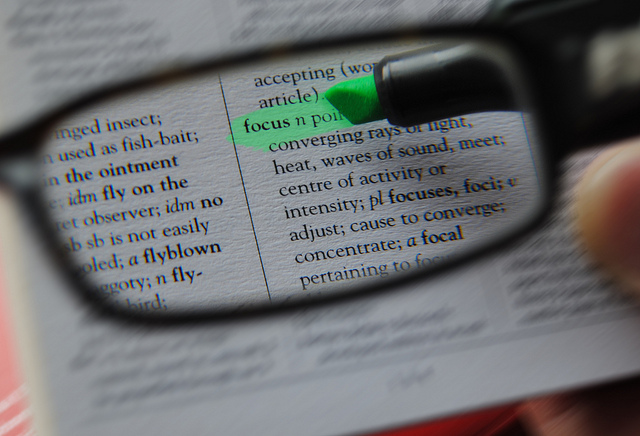Focus Is The Very Ideology Of Ideology


Focus, we assume, is a good thing. It is the stuff of the driven, the smart, the aware. We laud it without thinking. Focus! we snap at our kids as they daydream, play with a stray cheerio, babble on about aliens. Often, as we ready and rush for school at some god-awful hour of the morning, I’ll find my 10 year old son half naked in his room, one pant leg creeping up his calf as he plays with a freshly constructed Lego concoction, Vroom vroom…..bckshssssss….boom. Inevitably, I let the door fly and bark: Focus, dude, focus.
The assumption of focus pervades. We believe focus is a natural movement of the eye, the lens bending to account for the difference in distance of objects and light. It defines our cameras which proudly offer autofocus. And not only will the camera focus automatically, it will automatically focus on faces.
Focus, like all things, is ideological. It necessitates that one thing be clear, be the center, while the rest blur into periphery. Why do digital cameras focus on faces? Sure, it’s what most people photograph. But such is the way of focus: it keeps certain things fixed in view to the detriment of everything else. We privilege faces, the human. This is the very ideology that has lead to the decimation of the planet, the tyranny of the ego. The seemingly innocuous, even useful, autofocus on faces is destroying life itself.
But focus is not just ideological. It enacts the very ideology of ideology. Ideology is the demand of certain elements over others, a focus on this or that thing and the marginalization of other things. Focus, which we ideologically assume to be biological, enacts the hierarchy of a certain kind of knowledge and a certain mode of imperialist oppression.
Focus, for a moment, on your image of focus. The eye is the center to which the world comes, the center from which we observe. The world gathers itself to a point and radiates its energy, its very being, to a single point: the human eye, that conduit to the brain and its so-called intelligence. Or else our two eyes conspire together, like marksmen, to zero in on their target. In both cases, we see vision as pyramid, a hierarchy, inevitably moving to a center — either the subject (me) or the object.
We believe focus is so elemental that we find it difficult to imagine not focusing. I remember the first time I saw Andreas Gursky’s photographs. I couldn’t put my finger on what was so strange about them. And then I realized: there is no focal point. They are not pictures of per se — not pictures of people (portraits) or nature (landscapes). They sprawl, often infinitely in all directions. They are all in focus or all blur, which is what happens when you let life move.
Focus is constitutive of humanist ideology that imagines humans at the center of the world, our emotional lives essential, our dominion supreme. This logic of focus — this demand of focus — defines our sense of story. Hollywood (almost) always gives us one figure we that is at the center around which everything else revolves. We focus on Nemo and his terrible plight (he’s lost, it seems, and must be found). But then think of Loony Tunes. There is no focal point, no center. It’s all in focus at the same time that it’s all a blur of motion and mayhem. Which is to say, in Loony Tunes, we don’t focus on any one element: we see it all happening, a blur of action.
This is what we call empiricism: seeing it all, letting it all happen. What we usually do is come to the scene already focused. We see the face, we follow the ball, we root for Nemo. But there are other ways to see.
We can see without focus. This is where the scientist and the mystic meet. At their best, they come to the world unfocused, there eyes not zeroing in. On the contrary, their eyes go wide, go panorama, to take it all in. They resist focusing, resist putting any one thing at the center. A crappy scientist comes to his experiment, comes to the world, already knowing what’s going to happen. He comes to a world already in focus. The best scientist lets his eyes go slack, yet clear, to see what focus cannot. Of course, the scientist and the mystic do different things with their visions, the one theorizing while the other meditates.
And so I imagine a different architecture of vision, one not premised on hierarchy, pyramid, target, one not predicated on focus. I come back to Emerson’s transparent eyeball, an eye that is not the tool of the seer, an eye that is seeing, an eye that is not the center point but moves amidst the endless teem and flow of all things. Forget the seer who stands still to train his eye on his object. See the eye that is transparent, the world moving through it as it takes in the world as part of the world — an eye that is not the tool of an ego, a seeing that goes with the world.




